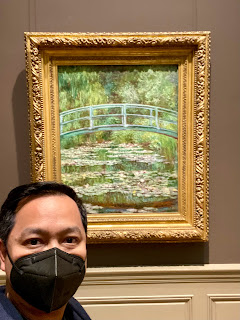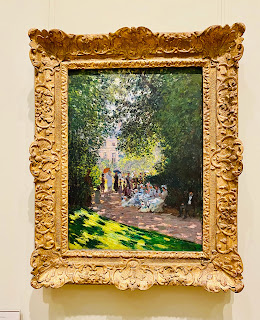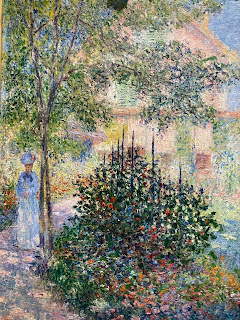 |
| Water Lilies (1919) by Claude Monet | Oil on canvas | 39 3/4 x 78 3/4 in. |
For me, seeing in person the great works of some of the world's most famous visual artists is like meeting your favorite film or music artists. On a freezing, sunny Saturday morning in February, my wife and I had the privilege to see the well-known paintings of Van Gogh, Monet, Matisse, Vermeer, and Picasso currently on exhibit at The Metropolitan Museum of Art (The Met) in New York City for free! Although I like visual arts, I am far from being an art aficionado. However, with a bit of research, I learned and was fascinated by the techniques used by these artists. There are thousands of paintings at The Met, but we focused our visit on the works of the above artists. Notes: The information about each painting (e.g., dimensions) are taken from the museum's website. The clearer copied images below are in the public domain, which means they can be freely copied, modified, and distributed even for commercial purposes. You can also access and study them up close on The Met's website.
Vincent Van Gogh (Dutch, 1853-1890)
Van Gogh is known for the impasto technique or laying thick layers of vibrant colors on canvas where brush or painting-knife strokes are visible. His common subjects include landscapes, figures, and still life. When I hear Van Gogh, I think of the night skies in his Starry Night (1889). That style of showing movement in his works is also seen in the Wheat Field with Cypresses. Van Gogh is also known for his many self-portraits, including Self Portrait with Bandaged Ear (1889), when he cut his right ear after losing his temper.
 
|
| Irises (1890) | Oil on canvas | 28 7/8 × 36 3/4 in. (73.2 × 93.4 cm)
|
 
|
| Wheat Field with Cypresses (1899) | Oil on canvas | 28 7/8 × 36 3/4 in. (73.2 × 93.4 cm |
 
|
| Self Portrait with a Straw Hat (1887) | Oil on canvas | 16 x 12 1/2 in. (40.6 x 31.8 cm) |
Claude Monet (French, 1840-1926)
Monet is the pioneer of the impressionist style of painting. Impressionism is characterized by the use of thin and relatively tiny but visible strokes. I have replicas of Monet's paintings at home, which we bought from a garage sale. Although the replicas are flat, I can see those thin and small strokes in Woman with a Parasol (1875) and Parc Monceau (1878). His typical subjects are picturesque landscapes of his immediate surroundings in France like gardens, wild grass on the hills, trees, and lilies. Also, his first wife Camille is seen as the model in many of his paintings. One of his most famous works displayed at The Met is the Bridge over a Pond of Water Lilies (1899).
Other famous works
 
|
Aristotle with a Bust of Homer (1653) Rembrandt van Rijn (Dutch, 1606-1669)
Oil on canvas 56 1/2 x 53 3/4 in. (143.5 x 136.5 cm) |
  |
| Madonna and Child Enthroned with Saints (ca. 1504) Raphael (Raffaello Sanzio or Santi, Italian 1483-1520) Oil and gold on wood Main panel, overall 67 7/8 x 67 7/8 in. (172.4 x 172.4 cm) |
Quick tips
When you visit art galleries, you must be very intentional. Check their website for the highlights of their exhibits. Read a little about the biography of the artists and the background of their paintings, such as the stories behind their work and the techniques they used. Set a goal which of their artworks you want to look for, then have fun hunting!


























Comments
Post a Comment